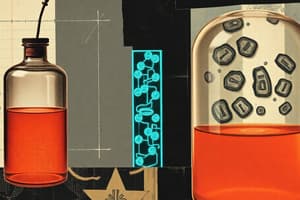Podcast
Questions and Answers
What is the primary function of an electrolyte in a galvanic cell?
What is the primary function of an electrolyte in a galvanic cell?
- To generate an electric current
- To separate the anode and cathode
- To facilitate the flow of electrons
- To facilitate the flow of ions between the anode and cathode (correct)
What type of reaction occurs during electrolysis?
What type of reaction occurs during electrolysis?
- Decomposition reaction (correct)
- Redox reaction
- Synthesis reaction
- Combustion reaction
What is the term for the loss of electrons during a redox reaction?
What is the term for the loss of electrons during a redox reaction?
- Oxidation (correct)
- Electrolysis
- Reduction
- Synthesis
What is the primary function of a galvanic cell?
What is the primary function of a galvanic cell?
What is the term for a device that stores energy in the form of chemical energy?
What is the term for a device that stores energy in the form of chemical energy?
What is an example of a redox reaction in everyday life?
What is an example of a redox reaction in everyday life?
Flashcards are hidden until you start studying
Study Notes
Electrolysis
- Definition: Electrolysis is the process of decomposing a substance using an electric current.
- Types:
- Electrolysis of water: 2H₂O → 2H₂ + O₂
- Electrolysis of molten sodium chloride: 2NaCl → 2Na + Cl₂
- Applications:
- Extraction of metals (e.g., aluminum, sodium)
- Production of chemicals (e.g., chlorine, hydrogen)
Galvanic Cells
- Definition: A galvanic cell is an electrochemical cell that generates a spontaneous redox reaction, producing an electric current.
- Components:
- Anode (oxidation occurs): where electrons are lost
- Cathode (reduction occurs): where electrons are gained
- Electrolyte: facilitates ion flow between anode and cathode
- Examples:
- Zinc-copper galvanic cell
- Daniel cell (zinc-copper sulfate)
Oxidation Reduction (Redox)
- Definition: Oxidation-reduction reactions involve the transfer of electrons between species.
- Oxidation: loss of electrons
- Reduction: gain of electrons
- Redox reactions:
- Combustion reactions
- Rusting of iron
- Photosynthesis
Batteries
- Definition: A battery is a device that stores energy in the form of chemical energy, which can be converted into electrical energy.
- Types:
- Primary batteries: non-rechargeable (e.g., alkaline, zinc-carbon)
- Secondary batteries: rechargeable (e.g., lead-acid, lithium-ion)
- Components:
- Anode
- Cathode
- Electrolyte
- Applications:
- Portable electronics
- Electric vehicles
- Renewable energy systems
Electrolysis
- Decomposing a substance using an electric current, resulting in the breakdown of a compound into simpler components.
- Two types of electrolysis:
- Electrolysis of water, which produces hydrogen and oxygen gases (2H₂O → 2H₂ + O₂).
- Electrolysis of molten sodium chloride, which produces sodium and chlorine (2NaCl → 2Na + Cl₂).
- Applications of electrolysis include:
- Extraction of metals like aluminum and sodium from their ores.
- Production of chemicals like chlorine and hydrogen.
Galvanic Cells
- A galvanic cell is an electrochemical cell that generates a spontaneous redox reaction, producing an electric current.
- Components of a galvanic cell include:
- Anode, where oxidation occurs and electrons are lost.
- Cathode, where reduction occurs and electrons are gained.
- Electrolyte, which facilitates the flow of ions between the anode and cathode.
- Examples of galvanic cells include:
- Zinc-copper galvanic cell.
- Daniel cell, a type of zinc-copper sulfate galvanic cell.
Oxidation Reduction (Redox)
- Oxidation-reduction reactions involve the transfer of electrons between species.
- Oxidation is the loss of electrons, while reduction is the gain of electrons.
- Examples of redox reactions include:
- Combustion reactions, which involve the burning of fuels.
- Rusting of iron, which is a slow oxidation process.
- Photosynthesis, which involves the conversion of light energy into chemical energy.
Batteries
- A battery is a device that stores energy in the form of chemical energy, which can be converted into electrical energy.
- Two types of batteries:
- Primary batteries, which are non-rechargeable (e.g., alkaline, zinc-carbon).
- Secondary batteries, which are rechargeable (e.g., lead-acid, lithium-ion).
- Components of a battery include:
- Anode, which is the negative electrode.
- Cathode, which is the positive electrode.
- Electrolyte, which facilitates the flow of ions between the anode and cathode.
- Applications of batteries include:
- Powering portable electronics.
- Electric vehicles.
- Renewable energy systems.
Studying That Suits You
Use AI to generate personalized quizzes and flashcards to suit your learning preferences.




